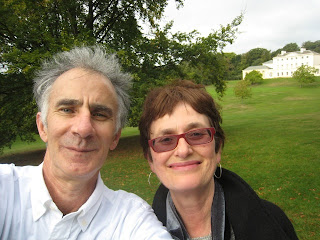'... wax gives rise to thoughts of mortality; it burns, it melts down, it suggests the vanity of the world, the weak candle flame of hope, the deliquescence of flesh. The material implies organic change ... Wax cheats death, it simulates life; it proves true and false ... " (Marina Warner, from Phantasmagoria: Spirit Visions, Metaphors, and Media (Oxford Universty Press, 2006).
On Saturday, along with our friends Barbara and Sue, we paid our very first visit to the Wellcome Collection in Euston Road. It certainly won't be our last. The current temporary exhibitions Mexican Miracle Paintings and Felicity Powell's Charmed Life - The Solace of Objects were both stunning, two of the most memorable we've seen here.
Powell's exquisite wax images on circular black glass (actually the backs of mirrors) are essentially her response to the Wellcome's collection of over 1400 amulets or charms that were amassed by amateur Edwardian folklorist Edward Lovett.
Her exhibition also incorporated an installation of a selection of these amulets grouped loosely into categories, including hearts, miniature shoes, horse shoes, etc. Some were beautiful, some like the dried mole's feet sheep's heart with pins and nails rather less so. Still, it was possible to sense the potency all of these much touched objects must have had for their original owners.
Images from top:
Water, Stars, Antlers, 2006
Tentacled, 2006
Spaghetti Head, 2006
All wax on glass, 5.9 cm/15 cm diameter
Images from top:
Water, Stars, Antlers, 2006
Tentacled, 2006
Spaghetti Head, 2006
All wax on glass, 5.9 cm/15 cm diameter













